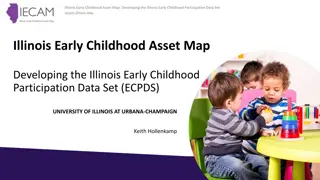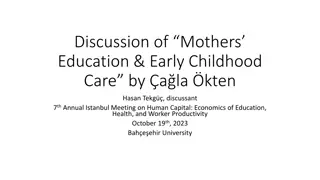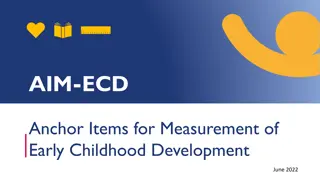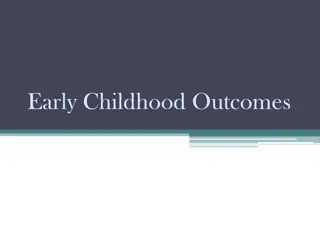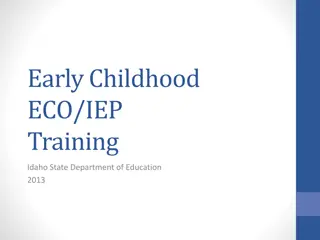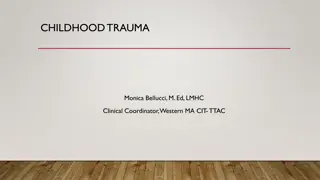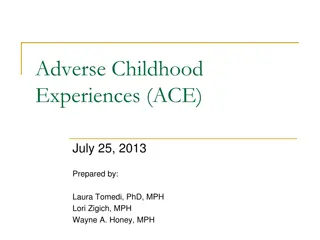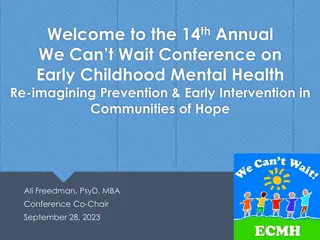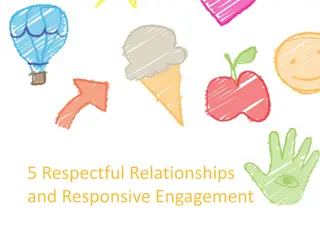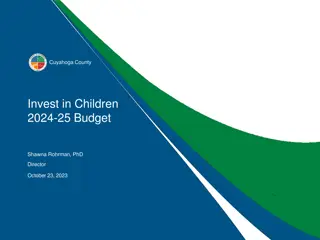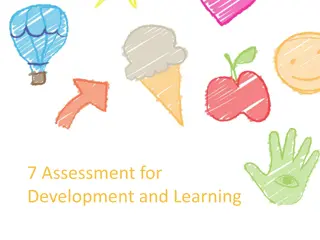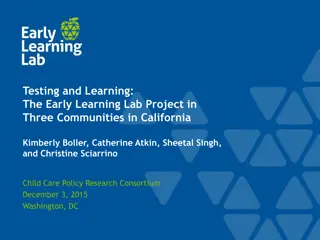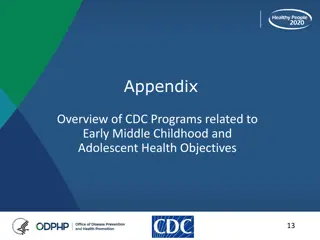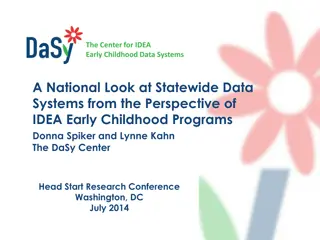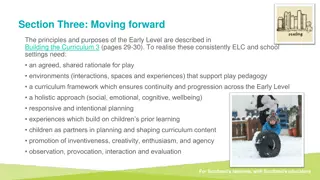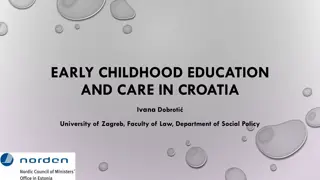Understanding the HighScope Approach in Early Childhood Education
The HighScope Approach is rooted in child development theory and research, emphasizing active learning and adult scaffolding. Children are encouraged to explore, make choices, communicate, and engage with diverse materials and ideas. This approach, based on the work of Piaget and Vygotsky, prioritizes hands-on experiences and child-led projects, with adults serving as facilitators rather than traditional supervisors.
Download Presentation

Please find below an Image/Link to download the presentation.
The content on the website is provided AS IS for your information and personal use only. It may not be sold, licensed, or shared on other websites without obtaining consent from the author. Download presentation by click this link. If you encounter any issues during the download, it is possible that the publisher has removed the file from their server.
E N D
Presentation Transcript
Teaching Young Children Study Material Early Year Curriculum Approaches High Scope Approach In ECCE Class Room Course facilitator Nighat Parveen
The High ScopeApproach The High Scope early childhood education approach, used in preschool, kindergarten, childcare, or elementary school settings, was developed in Michigan, in the 1960s. It is now common there and in some other countries.
Philosophy The philosophy behind HighScope is based on child development theory and research, originally drawing on the work of Jean Piaget and John Dewey. Since then, the High Scope Curriculum has evolved to include the findings of ongoing cognitive-developmental and brain research. The HighScope Curriculum draws upon the work of developmental psychologist and educator Lev Vygotsky, especially the strategy of adult scaffolding supporting children at their current developmental level and helping them build upon it in a social setting where children have opportunities to choose materials, ideas, and people to interact within the projects they initiate. The adults working with the children see themselves more as facilitators or partners than as managers or supervisors.
Active learning The HighScope Curriculum emphasizes active participatory learning.Active learning means students have direct, hands-on experiences with people, objects, events, and ideas. Children's interests and choices are at the heart of the HighScope programs. They construct their own knowledge through interactions with the world and the people around them. In active learning settings, adults expand children's thinking with diverse materials and nurturing interactions
The 5 Ingredients of Active Learning Materials Children s home, culture, and language are reflected in a variety of age appropriate, open-ended materials for them to explore. Manipulation Children make discoveries when they are encouraged to handle, examine, combine, and transform materials and ideas. Choice Children choose materials and play partners, change and build on their play ideas, and plan activities according to their interests and needs. Child language and thought Children communicate verbally and nonverbally thinking about their actions, expressing their thoughts about what they understand, and modifying their thinking as they learn and explore. Adult scaffolding Children gain knowledge and develop creative problem-solving skills with the help of well-prepared adults who support a child s current level of thinking and challenge them to advance to the next stage, also known as scaffolding.
Learning environment A HighScope school classroom is divided into well-defined interest areas that typically includes a home area, art area, block area, sand area, and music and movement that reflect the children's interests. Children are able to access all facilities independently as well as take some responsibility for use of these areas.
Corners (GOSHAY) Young children look for causal links in their experiences. For example; what happens when they pile up 20 blocks on top of each other, or what happens when they drop a pencil into a tub of water(sink or float) or what happens when they move a pencil or crayon on a flat surface, such as a wall, white board or paper? They need opportunities to explore these situations and come to their own conclusions. Their conclusios are based on limited experiences. Having learning corners for specific activities and storage of classroom equipment is an efficient and effective way of organizing children s learning experiences.
Learning corners encourage children to learn in ways that are natural to them; they allow children to work independently, in small groups or one-on-one with the teacher. Learning Corners provide for a wide range of abilities and interests where children can progress at their own pace/rate and repeat an activity for pleasure or reinforcement. Learning corners encourage children to be independent, make decisions and solve problems. They foster experimentation, curiosity and creativity.
These corners are ideal work spaces for children where they can learn in simulated real-life situations. Working in different corners helps develop children s ability to: Take initiative; make choices and decisions about what they are going to do (i.e. plan) and how they are going to do it. Complete self-chosen tasks and review their plans. Question, experiment, discover and make sense of the world around them
Work, share and cooperate with other children, thereby developing their social skills. Work independently towards mastery of different skills. Conform and follow to classroom rules. Reason and express themselves in a wide range of naturally occurring situations, thereby building their self- confidence. Learning corners need to be separated from each other. They also need space, such as low shelves or boxes/cartons to store the materials, storybooks and toys for the various corners. Three or more of the following learning corners can be set up at any given time:
Language Corner: This corner should be equipped with material related to increasing vocabulary and learning reading skills.(flash card,object basket etc) Library Corner: This corner should be set up with age appropriate big and small colourful books to promote the reading habit and to learn how to care for and value books. Art Corner: This corner provides children with opportunities for creative expression(Painting,Printing,CollageEtc). Math Corner: Appropriate material for the Math corner includes objects that will help children undrestand basic math concepts of size, shape, width, comparaision and number through direct experimentation. Science Corner: This corner should provide children with opportunities for observation and experimentation in order to understand the world around them.
Home Corner: The home corner should reflect the cultural background of the children where various kitchen utensils, clothes, small furniture and dolls can be provided. The Learning Corners should be organized in the context of the Key Learning Areas and Expected Learning Outcomes(SLOs), so that children have the opportunity to experiment with concepts and skills that have been introduced by the teacher.
THE DAILY ROUTINE OF AN ECCE CLASSROOM Young children need the comfort and security of a daily routine. They need to know what to expect during the school day. A daily routine provides a consistent, predictable sequence of events that gives them a sense of control over what they will be doing during the day. To make optimal use of the valuable time young children spend in school, a schedule needs to be made. The teacher s tasks become more focused and relatively easier to follow if a consistent routine is established, and children also get used to working in an organized and methodical way.
A daily routine is important because it Makes children feel secure when they know what to expect, creates an organized environment that is conducive to the learning process, helps children learn about sequencing, helps children understand the concept of the passage of time, helps teachers organize themselves and helps children realise that an activity has to be completed within a set time-frame.
A sample daily routine and explanation is given below. It can be varied depending on the school s hours and needs. The daily routine should be displayed using symbols/pictures for each activity, so that children, who are not yet reading can understand it
Greeting Circle: This is the time of day when the teacher gathers all the children together and greets them with a warm welcome by saying Assalam-u-Alaikum , Goodmorning , how are you? I am glad to see you here. Teacher will settle children recite Dua, sing the national anthem and morning song. Then the teacher will initiate general discussion that will include date, day, weather of the day, sharing what they did at home the previous day. The teacher can utilise this time to inculcate moral values among children for example being truthful, respectful, patient, tolerant, fair, just and polite. The teacher can also help children develop democratic and problem-solving skills by putting issues in front of the kids and seeking their suggestions to resolve it.
Group Work Time: During this segment of the daily routine, the teacher discusses concepts from the different Key Learning Areas, with all the children. Once the concept has been discussed, the teacher forms small groups and gives children activities to work on. The activities done at this time are planned and initiated and facilitated by the teacher. Small-group time During this time, a small group of children meet with an adult to experiment with materials, try out new skills, and solve problems. Adults develop a small-group activity based on children s interests and particular skills, materials, or content areas that suit children s developmental learning needs. Though the adult plans the activity and sets it in motion, children make choices about how to use the materials and freely communicate their ideas. Large-group time Large-group time builds a sense of community. Up to 20 children and two adults come together for movement and music activities, interactive storytelling, and other shared experiences. Children have many opportunities to make choices and play the role of leader
Outside Time: Children and adults spend at least 30 minutes outside every day, enjoying vigorous and often noisy play in the fresh air. This is the time for physical education exercises. The teacher can plan a series of bending, stretching, jumping and balancing activities for children s physical development. Equipment, such as large balls for catching and throwing, old tyres for walking in and out of, and medium-sized boxes for jumping over can also be used. Children will play on swings and slides, merry-go-round, and games like see-saw under the supervision of the teacher. This is also a time to discuss safety rules, such as making queues, avoiding pushing and taking turns.
Snack Time: A lot of valuable learning can take place if children have their snacks indoors in an organised way, under the teacher s guidance. Children will be asked to wash their hands before snack time. They can learn to spread the darri/dastarkhawn/mat and sit around it, giving each other space without pushing. They can say Bismillah or as per thier religion together and share their snack if someone has not brought their own. This is a good time to reinforce the importance of clean, boiled water and healthy food brought from home. The children can talk about the different kinds of food, healthy eating, learn to pour water without spilling, and clean up when everyone has finished
Plan Work Clean up Review Time Planning Time: Planning should be done in the central space on the darri/mat. This is the time of day when children have the opportunity to initiate the activity and take responsibility for their own learning. During planning time, children plan which Learning Corners they would like to work in, and what they hope to accomplish there. It is important to allow children to choose the learning corner/gosha themselves, and to encourage them to make their own decisions about what they will do there. Work/Gosha Time: During this time, children carry out their plans in the learning corners. In consultation and through discussion with the children, teachers should set some ground rules at the beginning of the year and discuss these frequently with them. For example: sharing and taking turns with the material; sharing materials and being considerate; talking very softly in all the corners, especially in the reading corner; listening and responding to the set signal when the time for learning corner /gosha work is finished; and tidying up and returning material to the designated place at the sound of the signal.
Clean-up Time: When the pre-determined clean-up signal is given by the teacher, children must tidy up and return the material they were using to their designated places. Review Time: Children come back to the central space on the mat/darri and talk about their learning corner/goshas work and whether they accomplished their plans for the day. Reviewing is a very important part of children s planning and working. There will be some children who may not have implemented their plans. They should be supported to identify reasons for this, by asking open-ended questions and letting them arrive at the answers. Where there are too many children in a class, this will undoubtedly be difficult; the teacher should ensure that each child gets the opportunity to review her/his work at least twice a week. V. Story and Rhyme Time: This time is set aside for storytelling and for songs and poems with actions. The children or the teacher can choose a book from the reading corner for story time. Children should be encouraged to tell stories that they have heard at home or in school or make their own stories.
High scope curriculum Adult(Teacher as facilitator)-child Interaction) Shared control between adults(Teacher as Facilitators) and children is central to the HighScope Curriculum. In addition to sharing control, participate in children's play, converse as partners with them, focus on children's strengths and offer them support, and encourage children's problem solving skill.
High scope curriculum Key developmental Areas In the HighScope Teaching YoungChildren Preschool Curriculum, learning is focused on the following eight content areas: Approaches to Learning Social and Emotional Development Physical Development and Health Language, Literacy, and Communication Mathematics Creative Arts Science and Technology Social Studies
HighScope Curriculum Key developmental Indicators The HighScope is organized into eight content areas: (1) approaches to learning; (2) language, literacy, and communication; (3) social and emotional development; (4) physical development and health; (5) mathematics; (6) science and technology; (7) social studies; and (8) creative arts. Within these content areas are 58 key developmental indicators (KDIs). The KDIs are statements of observable behaviors that define the important learning areas for young children. HighScope teachers keep these indicators in mind when they set up the learning environment and plan activities. Curriculum
HighScope Curriculum KDI Continued Provide teachers with a child development filter for observing and choosing appropriate interactions and activities Help teachers interpret what young children say and do along a developmental continuum Enable teachers to maintain reasonable expectations for young children Reinforce children s play as the primary mechanism for learning Allow teachers to be more knowledgeable and intentional in their daily planning for individual children and the class
HighScope Curriculum Active learning approach in the classroom? Shared Control Children construct their own knowledge of the world with the support of intentional teachers who shape and encourage their individual learning experiences. Teachers build on children s learning by planning activities based on what they observe in the classroom, providing materials and opportunities that both support and challenge young children. Children make their own discoveries and build their own initiatives by creating plans, following through on their intentions, and reflecting on their learning. This Plan- Do-Review process is a trademark of the HighScope approach and is the strategic backbone for children moving ,, through life. This unique dynamic shared control between the child and teacher lays the groundwork to actively engage young children in learning and helps children build essential development of skills
Social-Emotional Development Children learn and thrive when they are emotionally secure and socially connected to others. That s why we focus on the important social and emotional development of young children. In a HighScope program, teachers intentionally arrange the classroom and daily routines to develop children s sense of competence, support social interactions, and build a secure community. Our six steps for conflict resolution allow teachers to build children s language skills as they work through a conflict. As children gain control over their emotions and thoughts, their thinking and interactions become intentional leading to better executive function skills a key predictor of school success
Diversity Because families and cultures play important roles in young children s development, HighScope teachers strive to understand children s home cultures and create classroom environments that reflect children s home and community.
. In an early childhood classroom, its not unusual to have children whose first language is one other than English. In HighScope classrooms, adults encourage children to communicate regardless of which language they use, and acknowledge and support all verbal and non-verbal modes of communication. They understand that children learn a second language the same way that they learned their first with the support of caring Directress(Teacher) who are delighted at their attempts to communicate.
HighScopes active learning approach focuses on children s strengths and abilities, allowing teachers to individualize /inclusive learning for children with a broad range of abilities including those with special needs. Unlike some approaches where learning is sequenced across activities, HighScope sequences learning within activities so teachers are able to tailor their interactions to each child s cognitive ,. Physical ,social and emotional development.
https://www.youtube.com/watch?v=94Usgf_Q hnE&t=26s




